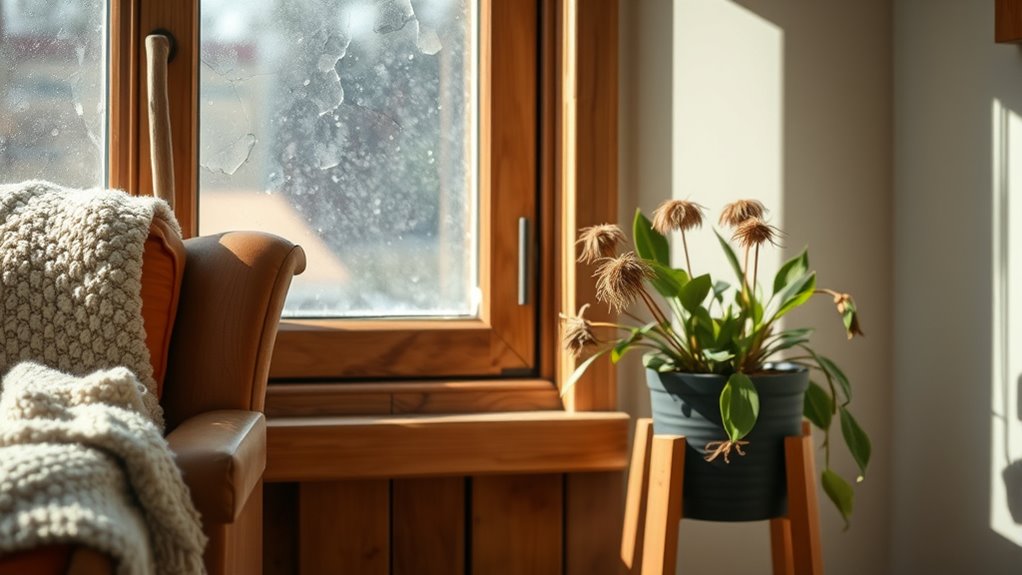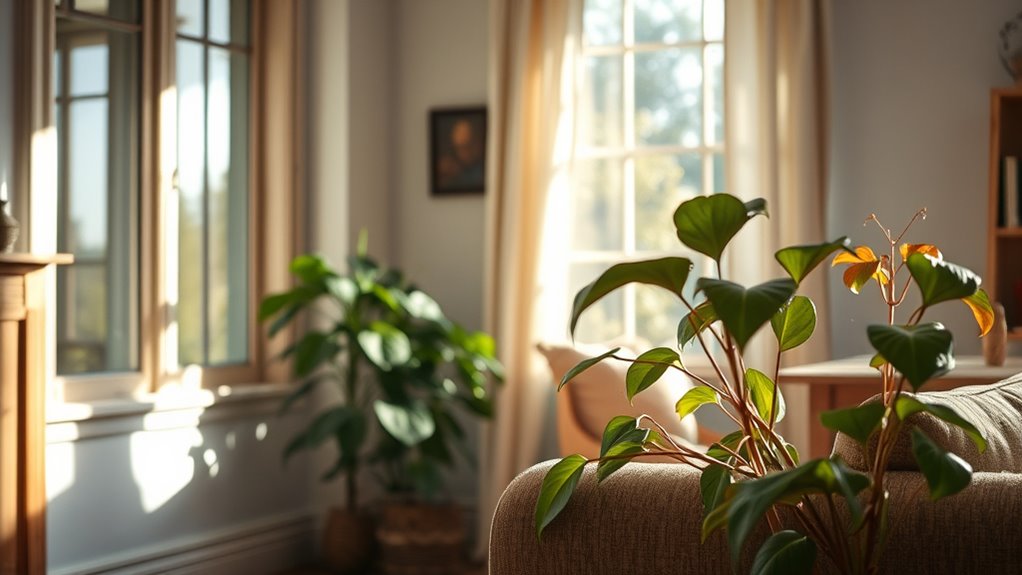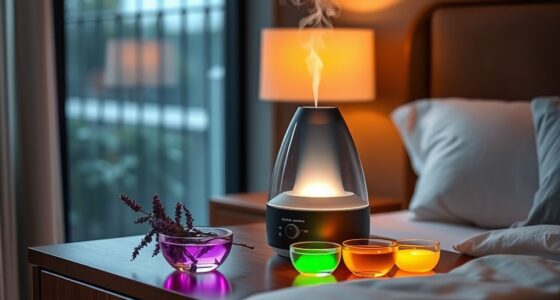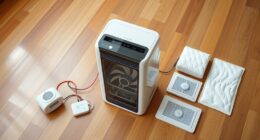If your home has cracked paint, warped furniture, or musical instruments, it’s a sign of low humidity. You might notice dust or allergens lingering more than usual, or experience frequent congestion and dry sinuses. Wilting houseplants with brown leaf edges can also signal dry air. You may feel chapped lips and dry skin, too. These signs point to a need for a humidifier, and there’s more you can do to improve your indoor air quality.
Key Takeaways
- Cracking or warping of wooden furniture, flooring, or musical instruments indicates prolonged low humidity.
- Persistent indoor dust, allergens, or airborne pathogens suggest dry air affecting air quality.
- Visible brown leaf edges or wilting houseplants signal inadequate indoor humidity levels.
- Static electricity shocks and frequent nasal or throat irritation are signs of dry indoor air.
- Structural issues like paint cracking or wallpaper peeling point to sustained low moisture in the environment.

During cold months or in dry climates, you might notice your home feels uncomfortably dry, but you may not realize it’s affecting your health and comfort. One of the key signs your home needs a humidifier is a noticeable drop in air quality. When the air is too dry, it can become a breeding ground for dust, allergens, and airborne pathogens, making breathing more difficult and increasing the risk of respiratory issues. You might find yourself sneezing more often, experiencing a sore throat, or feeling constant congestion. Dry air can also cause static electricity to surge, which is a minor but telling sign that humidity levels are too low.
Low humidity causes poor air quality, leading to allergies, respiratory issues, and static electricity signs.
Another indicator to watch for is the health of your houseplants. If your plants start wilting, develop brown leaf edges, or seem sluggish despite proper watering and care, the air’s dryness could be to blame. Plants rely on adequate humidity to absorb nutrients and maintain their cellular functions. When the air is parched, it hampers their ability to thrive, which signals that your indoor environment may need some moisture. This isn’t just about keeping your plants alive; healthy plants improve air quality by filtering pollutants and releasing oxygen, so their decline can directly impact your indoor air environment.
You might also notice physical discomforts like chapped lips, dry skin, or irritated sinuses, especially during winter or in arid conditions. These symptoms aren’t just minor annoyances—they’re signs that your home’s humidity levels are too low for ideal health. Dry air can cause your mucous membranes to become irritated, making you more susceptible to colds and respiratory infections. If you find yourself frequently reaching for lotion or tissues, it’s a clear indication that adding moisture to the air could enhance your overall comfort and well-being.
In addition to personal health, the structural integrity of your home can suffer from inadequate humidity. Wood furniture, musical instruments, and even paint can crack or warp when exposed to prolonged dryness. These signs, while more subtle, point toward a need for a humidifier to preserve not just your health but also your home’s condition. Recognizing these signs early can help you maintain a healthier, more comfortable indoor environment. If you notice these issues, investing in a humidifier can restore proper humidity levels, improve air quality, and support the health of your plants and home.
Furthermore, incorporating AI-driven sensors can help monitor indoor humidity levels accurately, providing real-time data to maintain optimal comfort and health.
Frequently Asked Questions
Can a Humidifier Help With Indoor Plants?
A humidifier can definitely help with indoor plants by improving plant hydration and soil moisture. When you add moisture to the air, it creates a more favorable environment for your plants, especially in dry homes. This prevents wilting, browning leaves, and dehydration. Keep the humidity levels balanced, and your plants will thrive with healthier foliage and stronger roots, making your indoor garden more vibrant and lush.
How Does Humidity Affect My Home’S Furniture?
Humidity levels directly impact your home’s furniture. If the air is too dry, wood furniture can crack or warp, and paint may peel or flake. Maintaining proper humidity helps preserve the integrity of your furniture, preventing damage and extending its lifespan. You should monitor indoor humidity to keep it balanced, ensuring your wood furniture remains smooth and your paint stays intact. A humidifier can help you achieve ideal moisture levels effortlessly.
Are There Health Risks From Excessive Indoor Humidity?
Think of excessive humidity as a garden overwatered—your home can become a breeding ground for mold growth and allergy symptoms. High indoor moisture levels can lead to mold spreading on walls and ceilings, aggravating respiratory issues. You might notice increased allergy symptoms or stuffy noses. To keep your home safe, monitor humidity levels and use a humidifier or dehumidifier as needed to prevent health risks from too much moisture.
What’S the Ideal Humidity Level for a Home?
You should aim for a humidity level between 30-50% in your home. Maintaining this range helps prevent mold growth and keeps allergens like dust mites and mold spores in check, promoting allergy relief. Too high humidity can lead to mold issues, while too low can cause dry skin and respiratory discomfort. Using a humidifier can help you maintain the ideal balance, ensuring a healthier, more comfortable living environment.
Can a Humidifier Improve Indoor Air Quality?
A humidifier can definitely improve your indoor air quality. It reduces airborne allergens by keeping the air moist, which helps trap dust and other particles. Additionally, maintaining proper humidity levels can prevent mold growth, which thrives in dry environments. When you use a humidifier correctly, it creates a healthier home environment, easing breathing issues and reducing allergy symptoms. Just be sure to keep it clean to avoid mold and bacteria buildup.
Conclusion
Think of your home as a delicate garden. Just like plants wither without enough moisture, your space suffers when the air’s too dry. A humidifier acts like a gentle rain, restoring balance and nurturing your environment. When you notice the signs, don’t let your home become a barren landscape. Embrace the moisture, and watch your space flourish with comfort and essentiality. Keep the air just right, and your home will thrive like a well-tended garden.









